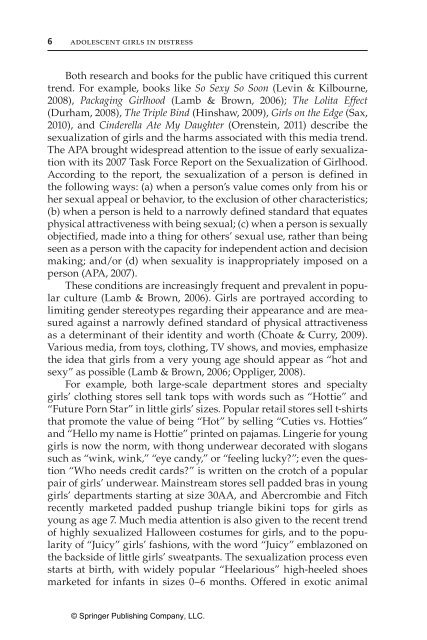Adolescent Girls in Distress - Springer Publishing Company
Adolescent Girls in Distress - Springer Publishing Company
Adolescent Girls in Distress - Springer Publishing Company
Create successful ePaper yourself
Turn your PDF publications into a flip-book with our unique Google optimized e-Paper software.
6 adolescent girls <strong>in</strong> distress<br />
Both research and books for the public have critiqued this current<br />
trend. For example, books like So Sexy So Soon (Lev<strong>in</strong> & Kilbourne,<br />
2008), Packag<strong>in</strong>g Girlhood (Lamb & Brown, 2006); The Lolita Effect<br />
(Durham, 2008), The Triple B<strong>in</strong>d (H<strong>in</strong>shaw, 2009), <strong>Girls</strong> on the Edge (Sax,<br />
2010), and C<strong>in</strong>derella Ate My Daughter (Orenste<strong>in</strong>, 2011) describe the<br />
sexualization of girls and the harms associated with this media trend.<br />
The APA brought widespread attention to the issue of early sexualization<br />
with its 2007 Task Force Report on the Sexualization of Girlhood.<br />
Accord<strong>in</strong>g to the report, the sexualization of a person is def<strong>in</strong>ed <strong>in</strong><br />
the follow<strong>in</strong>g ways: (a) when a person’s value comes only from his or<br />
her sexual appeal or behavior, to the exclusion of other characteristics;<br />
(b) when a person is held to a narrowly def<strong>in</strong>ed standard that equates<br />
physical attractiveness with be<strong>in</strong>g sexual; (c) when a person is sexually<br />
objectified, made <strong>in</strong>to a th<strong>in</strong>g for others’ sexual use, rather than be<strong>in</strong>g<br />
seen as a person with the capacity for <strong>in</strong>dependent action and decision<br />
mak<strong>in</strong>g; and/or (d) when sexuality is <strong>in</strong>appropriately imposed on a<br />
person (APA, 2007).<br />
These conditions are <strong>in</strong>creas<strong>in</strong>gly frequent and prevalent <strong>in</strong> popular<br />
culture (Lamb & Brown, 2006). <strong>Girls</strong> are portrayed accord<strong>in</strong>g to<br />
limit<strong>in</strong>g gender stereotypes regard<strong>in</strong>g their appearance and are measured<br />
aga<strong>in</strong>st a narrowly def<strong>in</strong>ed standard of physical attractiveness<br />
as a determ<strong>in</strong>ant of their identity and worth (Choate & Curry, 2009).<br />
Various media, from toys, cloth<strong>in</strong>g, TV shows, and movies, emphasize<br />
the idea that girls from a very young age should appear as “hot and<br />
sexy” as possible (Lamb & Brown, 2006; Oppliger, 2008).<br />
For example, both large-scale department stores and specialty<br />
girls’ cloth<strong>in</strong>g stores sell tank tops with words such as “Hottie” and<br />
“Future Porn Star” <strong>in</strong> little girls’ sizes. Popular retail stores sell t-shirts<br />
that promote the value of be<strong>in</strong>g “Hot” by sell<strong>in</strong>g “Cuties vs. Hotties”<br />
and “Hello my name is Hottie” pr<strong>in</strong>ted on pajamas. L<strong>in</strong>gerie for young<br />
girls is now the norm, with thong underwear decorated with slogans<br />
such as “w<strong>in</strong>k, w<strong>in</strong>k,” “eye candy,” or “feel<strong>in</strong>g lucky?”; even the question<br />
“Who needs credit cards?” is written on the crotch of a popular<br />
pair of girls’ underwear. Ma<strong>in</strong>stream stores sell padded bras <strong>in</strong> young<br />
girls’ departments start<strong>in</strong>g at size 30AA, and Abercrombie and Fitch<br />
recently marketed padded pushup triangle bik<strong>in</strong>i tops for girls as<br />
young as age 7. Much media attention is also given to the recent trend<br />
of highly sexualized Halloween costumes for girls, and to the popularity<br />
of “Juicy” girls’ fashions, with the word “Juicy” emblazoned on<br />
the backside of little girls’ sweatpants. The sexualization process even<br />
starts at birth, with widely popular “Heelarious” high-heeled shoes<br />
marketed for <strong>in</strong>fants <strong>in</strong> sizes 0–6 months. Offered <strong>in</strong> exotic animal<br />
© Spr<strong>in</strong>ger Publish<strong>in</strong>g <strong>Company</strong>, LLC.
















